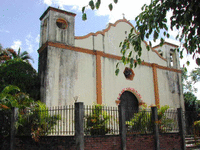Part of what's at issue in the debate, such as it is, over posthegemony is a matter of differing definitions. Thus Binford et. al. draw on Raymond Williams and (especially) William Roseberry, whereas I prefer to read hegemony theory through Gramsci and Laclau. It became clear in the Vegas session itself that those declaring themselves against posthegemony were equally opposed to Laclau's reformulation of hegemony itself.
In many ways that's fair enough, but the signal service provided by Laclau is to provide a real theorization of the concept of hegemony. Binford and friends, by contrast, fall back on "hegemony" as a catch-all notion that sounds sophisticated but ends up merely confused.
 Here's an example, from Binford's own otherwise very interesting essay "Peasants, Catechists, Revolutionaries," on the role of the Catholic church in Northern Morazán, which would come to be the heartland of FMLN territory during the civil war, and site of the FMLN's unofficial "capital," Perquín. Describing the conservative theology and pastoral practice of the region's only pre-war priest, Binford states that:
Here's an example, from Binford's own otherwise very interesting essay "Peasants, Catechists, Revolutionaries," on the role of the Catholic church in Northern Morazán, which would come to be the heartland of FMLN territory during the civil war, and site of the FMLN's unofficial "capital," Perquín. Describing the conservative theology and pastoral practice of the region's only pre-war priest, Binford states that:These beliefs established Catholicism as an important underpinning of the regional hegemonic order, defining hegemony here as a system of beliefs and practices that favor dominant groups and that serve as frames that shape people's lived experience, even their experience of struggle against oppression. (108; emphasis in original)There follows a footnote that refers to Williams's Marxism and Literature and to Roseberry's "Hegemony and the Language of Contention," but to no particular passages from either work.
On the one hand, this sentence is so banal as to be unarguable. Of course, Catholicism (or rather, the orthodox, pietistic Catholicism that preceded the changes initiated by Vatican II) played an important part in securing regional order. On the other hand, in so far as Binford purports to be explaining the mechanisms by which this order was secured, his statement here is opaque in the extreme.
For instance, what exactly is the relation between "hegemony" and "hegemonic order"? And why not, say, talk of the hegemonic underpinning of regional order? In other words, what is the relation between the Church and this "regional order" of which Binford writes? In what ways did Catholicism "underpin" this order rather than being itself part of it? What is meant by seeing beliefs and practices as "frames that shape people's lived experience," so apparently distinguishing them from experience? What is this metaphor of framing, and what does it actually mean?
In short, why does Binford wish to separate out hegemony from the other components of the society he is describing, putting it on another level (underpinning) or transcending (framing) that society? I think it's because he's trying to make the concept do some analytic work, to present it as some (semi-)external mechanism or cause to explain apparent peasant docility. Because peasants are themselves, of course, naturally rebellious, somehow in themselves endlessly "struggl[ing] against oppression." But even the very language that Binford uses ("beliefs and practices") gets hegemony entangled again within the experience and behavior that the concept allegedly explains.
Far from an explanatory concept, hegemony becomes "hegemonic order" and so little more than a redescription of the phenomena that Binford sets out to analyze. The terminological shift from "regional order" to "hegemony" to "regional hegemonic order" in fact explains nothing, adds nothing to our understanding of the relations between Catholicism, subalterns, and elites. It leads only to confusion masking as sophistication, bereft of any foundation beyond the gestural.
No comments:
Post a Comment